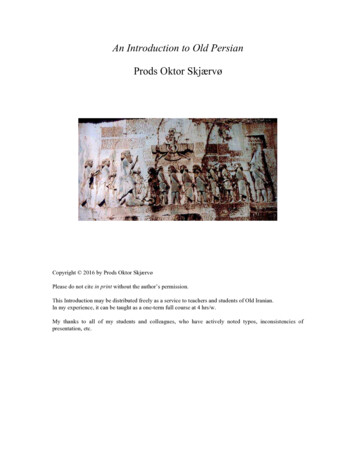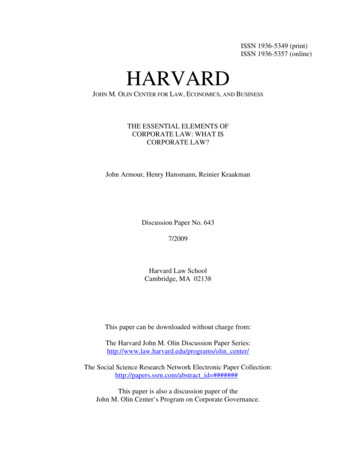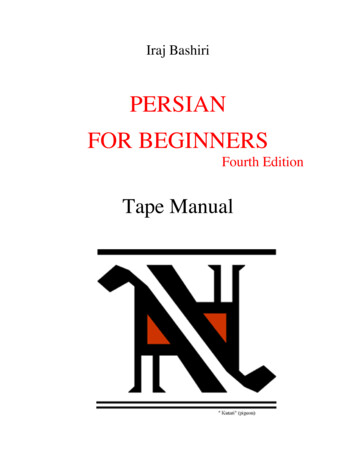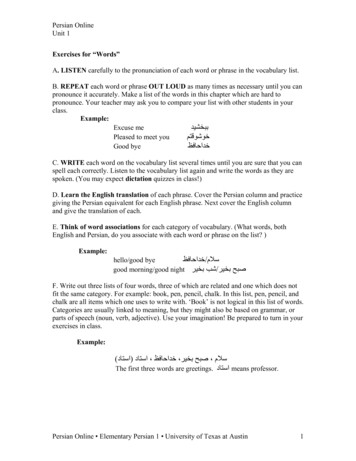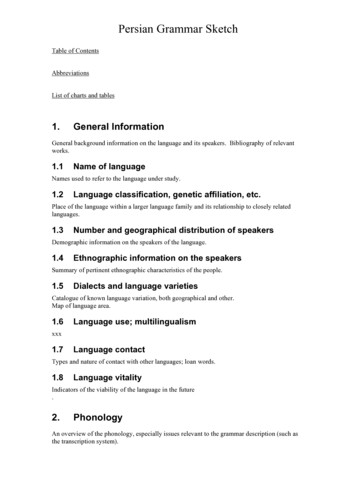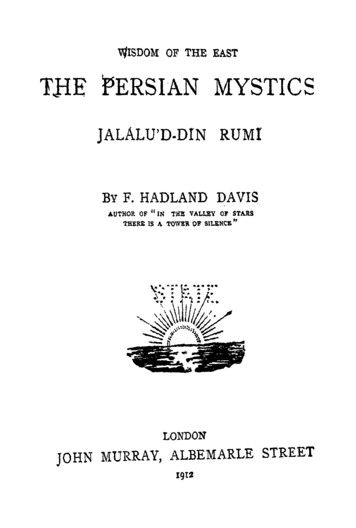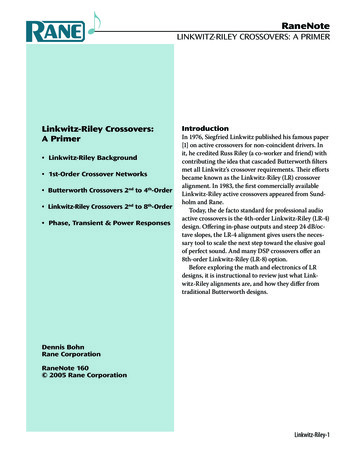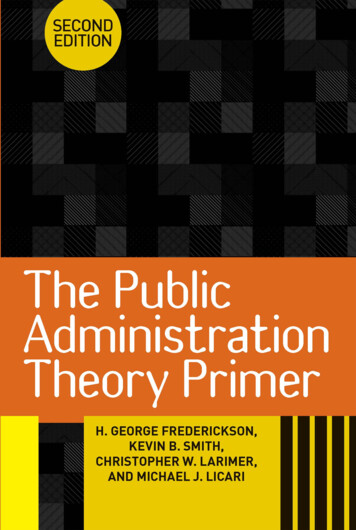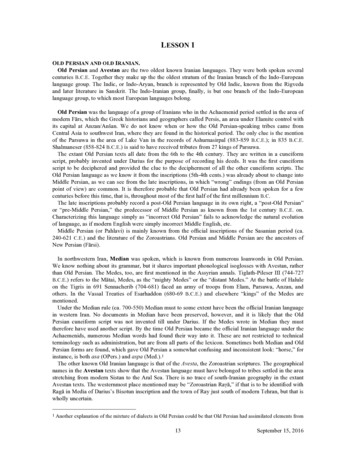
Transcription
LESSON 1OLD PERSIAN AND OLD IRANIAN.Old Persian and Avestan are the two oldest known Iranian languages. They were both spoken severalcenturies B.C.E. Together they make up the the oldest stratum of the Iranian branch of the Indo-Europeanlanguage group. The Indic, or Indo-Aryan, branch is represented by Old Indic, known from the Rigvedaand later literature in Sanskrit. The Indo-Iranian group, finally, is but one branch of the Indo-Europeanlanguage group, to which most European languages belong.Old Persian was the language of a group of Iranians who in the Achaemenid period settled in the area ofmodern Fārs, which the Greek historians and geographers called Persis, an area under Elamite control withits capital at Anzan/Anšan. We do not know when or how the Old Persian-speaking tribes came fromCentral Asia to southwest Iran, where they are found in the historical period. The only clue is the mentionof the Parsuwa in the area of Lake Van in the records of Ashurnasirpal (883-859 B.C.E.); in 835 B.C.E.Shalmaneser (858-824 B.C.E.) is said to have received tributes from 27 kings of Parsuwa.The extant Old Persian texts all date from the 6th to the 4th century. They are written in a cuneiformscript, probably invented under Darius for the purpose of recording his deeds. It was the first cuneiformscript to be deciphered and provided the clue to the decipherment of all the other cuneiform scripts. TheOld Persian language as we know it from the inscriptions (5th-4th cents.) was already about to change intoMiddle Persian, as we can see from the late inscriptions, in which “wrong” endings (from an Old Persianpoint of view) are common. It is therefore probable that Old Persian had already been spoken for a fewcenturies before this time, that is, throughout most of the first half of the first millennium B.C.The late inscriptions probably record a post-Old Persian language in its own right, a “post-Old Persian”or “pre-Middle Persian,” the predecessor of Middle Persian as known from the 1st century B.C.E. on.Characterizing this language simply as “incorrect Old Persian” fails to acknowledge the natural evolutionof language, as if modern English were simply incorrect Middle English, etc.Middle Persian (or Pahlavi) is mainly known from the official inscriptions of the Sasanian period (ca.240-621 C.E.) and the literature of the Zoroastrians. Old Persian and Middle Persian are the ancestors ofNew Persian (Fārsi).In northwestern Iran, Median was spoken, which is known from numerous loanwords in Old Persian.We know nothing about its grammar, but it shares important phonological isoglosses with Avestan, ratherthan Old Persian. The Medes, too, are first mentioned in the Assyrian annals. Tiglath-Pileser III (744-727B.C.E.) refers to the Mātai, Medes, as the “mighty Medes” or the “distant Medes.” At the battle of Haluleon the Tigris in 691 Sennacherib (704-681) faced an army of troops from Elam, Parsuwa, Anzan, andothers. In the Vassal Treaties of Esarhaddon (680-69 B.C.E.) and elsewhere “kings” of the Medes arementioned.Under the Median rule (ca. 700-550) Median must to some extent have been the official Iranian languagein western Iran. No documents in Median have been preserved, however, and it is likely that the OldPersian cuneiform script was not invented till under Darius. If the Medes wrote in Median they musttherefore have used another script. By the time Old Persian became the official Iranian language under theAchaemenids, numerous Median words had found their way into it. These are not restricted to technicalterminology such as administration, but are from all parts of the lexicon. Sometimes both Median and OldPersian forms are found, which gave Old Persian a somewhat confusing and inconsistent look: “horse,” forinstance, is both asa (OPers.) and aspa (Med.).1The other known Old Iranian language is that of the Avesta, the Zoroastrian scriptures. The geographicalnames in the Avestan texts show that the Avestan language must have belonged to tribes settled in the areastretching from modern Sistan to the Aral Sea. There is no trace of south-Iranian geography in the extantAvestan texts. The westernmost place mentioned may be “Zoroastrian Raγā,” if that is to be identified withRagā in Media of Darius’s Bisotun inscription and the town of Ray just south of modern Tehran, but that iswholly uncertain.1Another explanation of the mixture of dialects in Old Persian could be that Old Persian had assimilated elements from13September 15, 2016
LESSON 1The language of the oldest Avestan texts (Old Avestan) is very close to that of the Old Indic Rigveda andas such is of a very archaic Indo-European type. The language of the later Avesta (Young or Late Avestan)texts is more similar to the language of the oldest Old Persian inscriptions than to Old Avestan. It istherefore not unlikely that Avestan was a language spoken in northeastern and eastern Iran from the secondhalf of the 2nd millennium (Old Avestan) down to about the beginning of the Achaemenid period (YoungAvestan).SCRIPT. ORIGIN.Opinions vary about who invented and first used the Old Persian script: the Medes or Darius for hisBisotun inscription. There are two important pieces of evidence to be considered: 1. the dating of theinscriptions of Cyrus the Great (Cyrus II) at Pasargadae and 2. the meaning of §70 of the Bisotuninscription, in which Darius speaks about the inscription.As for point 1, it has been conclusively shown that the Old Persian version of Cyrus’s inscription doesnot date from his time, but is a later addition. There are therefore no inscriptions from before Darius I, sincethose attributed to Ariaramnes and Arsames are modern, less likely antique, forgeries.As for point 2, the interpretation of DB §70 hinges on the meaning of the expression ima dipi-ciçamadam akunavam patišam ariyā utā pavastāy[ā] utā carmā gar[x x x x x x x x] “I made this form ofinscription. And it [was?] Aryan and both on tablet(s) and on parchment.” The expression dipi-ciçam “formof inscription”2 is likely to refer to the new script, but other interpretations may be possible.SCRIPT. WRITING SYSTEM.In the following description of the Old Persian script system, pointed brackets are used to indicate the“transliteration,” that is the (English) value of the sign(s) in the syllabary. When we want to indicate thepronunciation of a word, we “transcribe” it, for instance, the transliteration ba-ga-a reproduces thespelling bga, while the transcription bagā indicates the pronunciation of the word.Old Persian is written in a cuneiform script, but with only a small number of signs compared tolanguages such as Sumerian and Akkadian. There are three vowel signs a, i, u , 33 consonant signs CV ,3 8 so-called ideograms or logograms, that is, signs that stand for a whole word, and a sign thatserves to mark the end of words (word separator). In addition there are signs for the numerals. Theinventory of signs is referred to as the “syllabary.”The consonant signs are syllabic, that is, they note consonant vowel CV . The “inherent” vowel of asingle sign is a, i, or u Ca, Ci, Cu . The syllabary does not contain a complete set of Ci and Cu signs, however: there are only 4 Ci signs and 7 Cu signs. The Ca signs are therefore in a senseneutral (or “unmarked”), as they also have to serve for the missing Ci and Cu signs. In addition Ca signs are used where a consonant is followed by no vowel, that is, when followed by other consonants orwhen it is the last sound of a word (in final position). Ca signs are therefore often transliterated simply as C . In this manual Ca is used.The vowel signs a, i, u are used initially (when the word begins with a vowel) and to write longvowels. The signs i and u are also used to write the vowels i and u, less commonly ī and ū. They arepreceded by the Ci and Cu signs whenever these exist. Very rarely Ci and Cu are used alone toindicate consonant plus i or u.23Reading proposed by R. Schmitt.C consonant, V vowel.14September 15, 2016
LESSON 1THE SYLLABARY.CaaAbcçdfghjklmnprsπtƒvxyYz.,Ci a Cui i u u D di du gu ku ă ba ca ça da fa ga ha ja J ji ka la ma Mµ mi na mu nu pa ra ru † tu sa ša ta θa va V vi xa ya za : (word dividers)The forms Y ya and , : are used in Darius’s Behistun (Bisotun) inscription (DB).The formsA ă is found once. The form Å is a mistake found once.15September 15, 2016
LESSON 1LOGOGRAMS.XH B UıË XŠ xšāyaθiya DH1 dahạyāuš DH2 dahạyāuš BG baga BU būmiš AM1 Auramazdā AM2 Auramazdā AMha AuramazdāhaTABLE OF SIGNS ACCORDING TO COMPONENTS.kszƒyMf†Adacπ ka sa za θa ya mi fa tu ă gh ux çmvjVJ Bi ku ga ha gu du u xa nu ça nbtXrDµl ma va ja vi ji ru BG i na ba ta XŠ ra di mu la BU da a p pa ca ša NUMERALS.12345678912345678910)20 12)2)3)4)522 2 31314152327 5 6 7120º 25261819)8)916September 15, 2016
LESSON 1SCRIPT. TRANSCRIPTION.In the transcription of Old Persian the choice of English letters to represent the sounds of Old Persian isof a standard international type.The following two points should be noted:When Ci and Cu are used alone to indicate consonant plus i or u the vowel is usually transliteratedas superscript: vi, gu.Certain sounds that are expected from the etymology (linguistic history) of the word are not written in theOld Persian script. In the grammar and vocabularies below these are indicated by superscript letters(Ahuramazdāh, bandakah, abarat, abaran), but in the text examples they are omitted.Examples:Old PersianbgkarmamJiymnVƒiyaptiyJv u uπsu udsu dzurbdkTransliteration ba-ga ka-a-ra ma-a-ma ji-i-ya-ma-na vi-θa-i-ya-a pa-ta-i-ya ji-va ku-u-ru-u-ša sa-u-gu-u-da sa-u-gu-da za-u-ra ba-da-ka Transcription (normalization)bagakāramāmjiyamnaviθiyā (viθiyā)patiyjiva (jīva)KurušSugudaSuguda (Suguda)zura (zūra)bandaka (bandaka)PHONOLOGY. PRONUNCIATION.The simple vowels may be pronounced as in German or Spanish, rather than as in English:aiuaiauas in Germ. Mann, Span. gato, Eng. mustas in Germ. ist, Span. chico, Eng. beat (but short)as in Germ. und, Span. uno, Eng. putas in Germ. Kaiser, Span. baile, Eng. lieas in Germ. Haus, Span. causa, Eng. howThe long vowels ā, ī, ū are pronounced like the short ones, only longer.The combination ạr should probably be pronounced [ǝr] (as in English courageous, French ferais).Similarly, hạ should be pronounced [hǝ], or possibly [hi].The consonants p, t, k, may be pronounced either without aspiration as in the Romance languages (e.g.,Spanish) or with aspiration as in the Germanic languages (English, German, etc.) or in Persian, as we donot know how they were pronounced in Old Persian.Old Persian s is always pronounced [s] as in sing, never [z] as in zero, for which Old Persian uses z.17September 15, 2016
LESSON 1Special transcription letters include:as Eng. ch in child or Ital. cento.as Eng. j in judge.to be pronounced as s. We do not know the exact pronunciation of this letter. It may have been [sr].Historically ç comes from older θr.θ as Eng. th in thing.x as Germ. ch in auch (not as in ich), Spanish Span. j, as in bajo [baxo] (not as in American Span.[baho]).š as Eng. sh in shall, fish.cjçPHONOLOGY. STRESS.We do not know the rules for Old Persian stress, but some rules may be formulated from comparisonwith other Iranian languages and Indic.In words of two, three, or four syllables, the heavy syllable closest to the end of the word, not countingthe last syllable, probably took the stress. Here “heavy syllable” a syllable with a long vowel or adiphthong or a short vowel followed by more than one consonant (or an unwritten n or h cons.) and “lightsyllable” syllable with a short vowel followed by only one consonant:kā ra, Višt āspa, ām ātā, Auramazd āha, kāsakáinavaz ạrka, Auramázdā, Ariyārámnafr ābara, duvit āparanammártiya, víspazanāWe have no way of knowing whether words with a closed final syllable ( a final syllable with a finalconsonant) could be stressed on the last syllable, for instance, Kurauš: Kúrauš or Kuráuš, and dahạyauš:dáhạyauš or dahạyáuš.In words with several short syllables the stress moved toward the beginning of the word: bága, návama,but we do not know how far it was allowed to go and so, for instance, where the stress lay in hamaranakaraand other words with four or more short syllables, e.g.: ákunavam or akúnavam, hámaranakara orhamáranakàra (à secondary stress), úšhamaranakara or ušhamáranakara.It is also possible, even probable, that new rules for stress developed in the Old Persian period, as MiddlePersian forms show that in some word patterns the stress moved to the second-to-last syllable (penult, orlast syllable if the final vowel had already been lost) also when it was light: naváma *nowóm4 (the newstress may represent a generalization of the stress of the genitive-dative: naváhạyā).In cases where a short vowel developed, as in xšāyaθiya, which is from *xšāyaθya, Haxāmanišiya *Haxāmanišya, or θanuvaniya *θanvanya, the position of the stress is a matter of conjecture. Thesewords may have been stressed either xšāyáθiya *xšāyáθya, Haxāmaníšiya *Haxāmaníšya, andθanuvániya, or xš āyaθiya, Hax āmanišiya, and θánuvàniya, according to the above rule (cf. Middle andNew Persian šāh xš āyaθiya?). We also do not know whether the stress shifted position in the genitivedative forms such as k̑ ārahạya kāráhạya ( *kārahya).Note also the case of marīka- *mariyaka- (cf. Av. mairiia-, OInd. márya-, maryaká-). The probabledevelopment is *máriyaka márīka mar īka, but it may also have been *maríyaka mar īka.4An asterisk (*) indicates that the word is not actually found, only reconstructed.18September 15, 2016
LESSON 1EXCERCISE 1Practice xamniπiy. da-a-ra-ya-va-u-ša : xa-ša-a-ya-θa-i-ya : va-za-ra-ka : vi-ša-ta-a-sa-pa-ha-ya-a : pa-u-ça : ha-xa-a-ma-na-i-ša-i-ya : Dārayavauš xšāyaθiya vazạrka Vištāspahạyā
Old Persian language as we know it from the inscriptions (5th-4th cents.) was already about to change into Middle Persian, as we can see from the late inscriptions, in which “wrong” endings (from an Old Persian point of view) are common. It is therefore probable that Old Persian had already been spoken for a few centuries before this time, that is, throughout most of the first half of the .File Size: 672KBPage Count: 50
